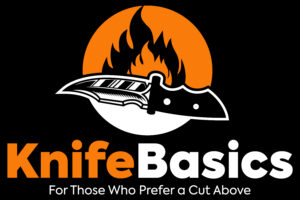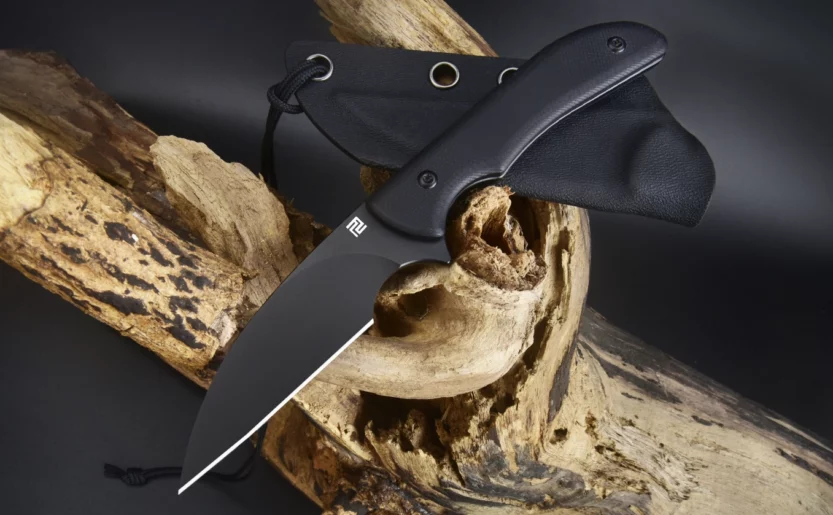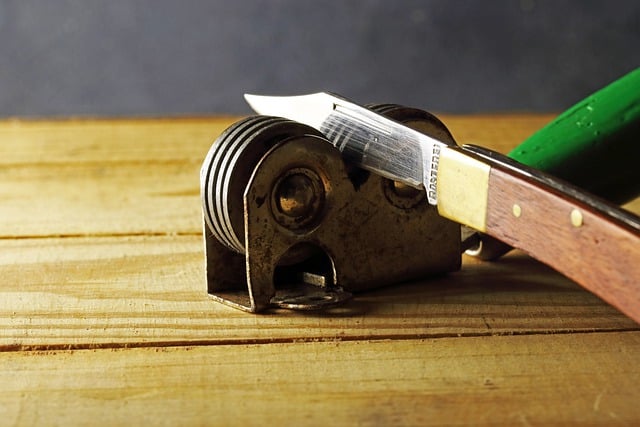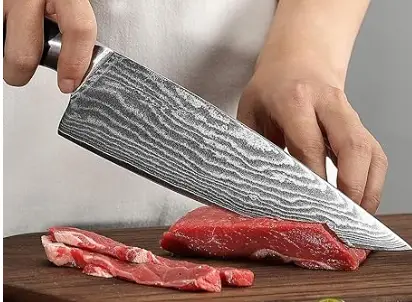What is AR-RPM9 Steel?
The company claims that powder AR-RPM9 stainless steel will boost the performance of the knife offerings in the budget category because its performance matches that of high-end steel.
A unique thing about Ar-rpm9 composition is that artisan lists RE elements to signify the presence of Rare earth elements. Artisan Cutlery, however, does not clarify what rare earth elements it uses but only lists RE at 0.05%.
AR-RPM9 Steel Composition (AR-RPM9 steel chart)
- Carbon C 0.9%: Increases the edge retention, hardness and tensile strength. It also improves steel resistance to wear, abrasion and corrosion.
- Chromium Cr 18.00%: Chromium Increases hardness, tensile strength and corrosion resistance of a blade.
- Molybdenum Mo 1.00%: Improves machinability and corrosion resistance.
- Vanadium V 0.10%: Forms hard vanadium carbide in combination with other elements that improve wear resistance.
- Manganese Mn 0.45%: improves the strength and hardness of steel. When the steel is heat-treated, hardenability is improved with increased manganese.
- Nickel Ni 0.60%: improves strength and toughness. It increases hardenability but not as much as some of the other alloying elements in steel. It can enhance corrosion resistance in significant amounts
- Silicon Si 0.80%: Increases strength and heat resistance.
- Rare Earth Re 0.05%:
What is RE in AR-RPM9 Steel?
Artisan Cutlery does not clarify which RE (Rare Earth) elements it uses in making AR-RPM9 steel though the most commonly found RE elements that are used in steel production are Cerium (Ce) and Lanthanum (La). One would think Artisan Cutlery could probably be using these two elements in AR-RPM9 stainless steel but this is not the case.
In a recent interview with Knife Newsroom, A representative of Artisan Cutlery clarified that RE “It’s essentially trace elements left over from the smelting process like sulfur, phosphorus, etc. The total of all the trace elements combined is less than 0.05%.”
Sulfur and Phosphorus are mostly impurities that occur during steel production and are not classified as rare earth elements. That statement by the Artisan Cutlery rep itself raises doubts whether RE is just but a marketing tactic.
AR-RPM9 steel properties
AR-RPM9 Steel Hardness
AR-RPM9 steel has a hardness of 58-60HRC as per the Rockwell hardness scale. This is high hardness expected to be found in high-end knives from reputable brands like Cold Steel or Spyderco.
The high hardness is associated with the high carbon content and the presence of vanadium and cobalt in its composition. The hard vanadium carbides formed to improve the hardness and wear resistance of AR-RPM9 steel.
AR-RPM9 Steel Edge retention
The edge retention of steel is directly influenced by its hardness. With a high hardness of 60 HRC, it is no surprise that knives made from this steel hold an edge for a long time.
The hard vanadium carbides also play a role in the ability of this steel to remain sharp for long, even with frequent use.
AR-RPM9 Steel Toughness
The toughness of steel is described as the ability of steel to absorb impact without fracturing, and it reduces with the hardness of steel.
With that said, it is expected that AR-RPM9 steel does not do well in toughness. It is not the most brittle steel out there, but there are tougher steels on the market.
The good news is that Artisan Cutlery realized this and included elements that boost the toughness of this steel, like nickel and manganese, in its composition. With these additions, we can describe the toughness of AR-RPM9 as decent.
AR-RPM9 Steel Corrosion resistance
As stated earlier, AR-RPM9 is stainless steel thanks to the 18% chromium in its composition. For a steel to be categorized as stainless steel, it should have at least 12% chromium in its composition. With 18%, the corrosion resistance abilities of this steel are at the same level as premium steel.
If you are on a budget and looking to buy a knife that will be used in highly corrosive environments, the varieties of AR-RPM9 steel will not disappoint.
What’s more, remember that all types of steel can rust if exposed to corrosive environments. Therefore, ensure to wash and dry your AR-RPM9 knives after use for a long-lasting rust-free service.
AR-RPM9 Steel Wear resistance
Wear resistance is the ability of steel to resist wear and abrasion and it is also directly affected by its hardness. Because of its high hardness, AR-RPM9 steel offers great wear resistance. The knives can be used in tough applications without chipping or breaking.
Although AR-RPM9 knives offer high wear resistance, you should only use them for applications within their ability; otherwise, using them for very tough applications like batoning will be like setting them up for failure.
Ease of sharpening AR-RPM9 Steel
AR-RPM9 is hard steel, which means that it is not that easy to sharpen. It is good that the knives do not become dull fast, but you will spend a bit more time and energy getting the sharp edge back. The sharpening process will be harder for you if you are a beginner at knife sharpening.
The good news is that normal aluminum oxide abrasives can still get you a sharp edge on Ar-rpm9 stainless steel knives.
AR-RPM9 Steel Equivalent
AR-RMP9 steel is basically equivalent to Chinese 9Cr18MoV steel and German 1.4112 stainless steel. They are both high carbon and chromium steels, with a hardness of 58-60 HRC. AR-RMP9 steel does not provide any significant difference in performance from these existing steels. Their compositions are identical only that AR-RPM9 steel features “Rare Earth” elements.
Related – 6 New Knife Steels To Look Out For
AR-RPM9 vs VG10 Steel
The main difference in terms of performance between AR-RPM9 steel and VG10 steel is that AR-RPM9 stainless steel offers slightly better corrosion resistance than Japanese VG10 stainless steel as it contains about 18% chromium elements in its alloy composition.
VG10 steel is a better performer than AR-RPM9 steel when it comes to edge retention and wear resistance. VG10 alloy composition contains a higher percentage of vanadium carbides which are excellent for edge retention and wear resistance.
AR-RPM9 knife steel and VG10 knife steel offer equal performance in toughness. Both blade steel can withstand a considerable amount of tough application without chipping or cracking. However, their toughness is low compared to other stainless steels like AEB-L steel and AUS 8 steel.
It will be much easier to sharpen an AR-RPM9 steel knife compared to sharpening a VG10 steel knife due to the reduced wear resistance of AR-RPM9 steel blades.
AR-RPM9 steel vs D2 steel
The main difference between AR-RPM9 steel and D2 steel is that AR-RPM9 steel is stainless steel while D2 steel is a non-stainless tool steel. AR-RPM9 Stainless steel blades offer excellent corrosion and rust resistance over D2 steel blades.
D2 steel offers a Rockwell hardness of about 63 HRC, while AR-RPM9 steel offers a Rockwell hardness of up to 60 HRC. This increased hardness in D2 blade steel gives it better edge retention and wear resistance over AR-RPM9 blade steel.
D2 knife steel is known for its excellent wear resistance; It, however, falls short when it comes to toughness. Powder AR-RPM9 knife steel beats D2 knife steel in toughness due to its production process and alloy composition. An AR-RPM9 knife is less likely to experience chipping and cracking compared to a D2 knife.
AR-RPM9 knife steel will be much easier to sharpen compared to D2 knife steel. D2 steel exhibits excellent wear resistance and contains hard carbides, which are good in edge retention but make it hard to sharpen.
Is AR-RPM9 good knife steel?
The only downside is that despite it being powdered steel it doesn’t offer nearly as good of edge retention as other powder steels from crucible industries like S30V stainless steel.
You should also take a look at the science involved in stainless steel knife making.
Check out this affordable CJRB folding knife with AR-RPM9 Steel. It also features G10 scales with a ceramic ball-bearing liner lock for fast deployment and closure. Check Current Prices.




